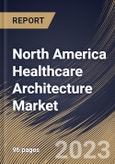Healthcare facilities are adopting flexible designs that can easily adapt to changing patient volumes and healthcare needs. This flexibility is crucial for addressing unexpected surges in patient numbers, as demonstrated during the pandemic. The rise of telehealth has led to the creation of dedicated telehealth spaces within healthcare facilities. These areas are designed to support virtual consultations and examinations, providing patients with a seamless and convenient healthcare experience.
Moreover, competition in the market is driven by several factors, including the need for sustainable and technologically advanced healthcare environments, compliance with stringent regulatory requirements, and the pursuit of optimal patient experiences. Leading architectural firms are constantly vying for projects that range from designing state-of-the-art hospitals and medical centres to renovating existing healthcare facilities to meet modern standards.
Many healthcare facilities in the United States have aging infrastructure that requires renovation or replacement. Hospitals and medical centres are investing in architectural upgrades to modernize their facilities, enhance patient experiences, and meet evolving healthcare standards. For example, the renovation and expansion of the Massachusetts General Hospital in Boston involved a significant investment in healthcare architecture to create state-of-the-art patient care spaces. In accordance with the Centres for Medicare & Medicaid Services of the Government of the United States, spending on healthcare in the United States increased by 2.7 percent in 2021 to $4.3 trillion, or $12,914 per person. Spending on healthcare accounted for 18.3 percent of the country's GDP. Owing to these factors, the market is expected to expand.
The US market dominated the North America Healthcare Architecture Market, By Country in 2022, and would continue to be a dominant market till 2030; thereby, achieving a market value of $2,787.3 million by 2030. The Canada market is experiencing a CAGR of 6.8% during (2023 - 2030). Additionally, The Mexico market would exhibit a CAGR of 5.8% during (2023 - 2030).
Based on Service Type, the market is segmented into New Construction, and Refurbishment. Based on Facility Type, the market is segmented into Hospitals, ASCs, Long Term Care Facilities & Nursing Homes, Academic Institutes, and Others. Based on countries, the market is segmented into U.S., Mexico, Canada, and Rest of North America.
The market research report covers the analysis of key stakeholders of the market. Key companies profiled in the report include HDR, Inc., Stantec, Inc., Perkins+Will (Dar Al-Handash Consultants), NBBJ L.P., Perkins Eastman, SmithGroup Companies, Inc., CannonDesign, Jacobs Engineering Group, Inc., HKS, Inc., and HOK Group, Inc.
Scope of the Study
Market Segments Covered in the Report:
By Service Type- New Construction
- Refurbishment
- Hospitals
- ASCs
- Long Term Care Facilities & Nursing Homes
- Academic Institutes
- Others
- US
- Canada
- Mexico
- Rest of North America
Key Market Players
List of Companies Profiled in the Report:
- HDR, Inc.
- Stantec, Inc.
- Perkins+Will (Dar Al-Handash Consultants)
- NBBJ L.P.
- Perkins Eastman
- SmithGroup Companies, Inc.
- CannonDesign
- Jacobs Engineering Group, Inc.
- HKS, Inc.
- HOK Group, Inc.
Unique Offerings
- Exhaustive coverage
- The highest number of Market tables and figures
- Subscription-based model available
- Guaranteed best price
- Assured post sales research support with 10% customization free
Table of Contents
Companies Mentioned
- HDR, Inc.
- Stantec, Inc.
- Perkins+Will (Dar Al-Handash Consultants)
- NBBJ L.P.
- Perkins Eastman
- SmithGroup Companies, Inc.
- CannonDesign
- Jacobs Engineering Group, Inc.
- HKS, Inc.
- HOK Group, Inc.
Methodology

LOADING...








